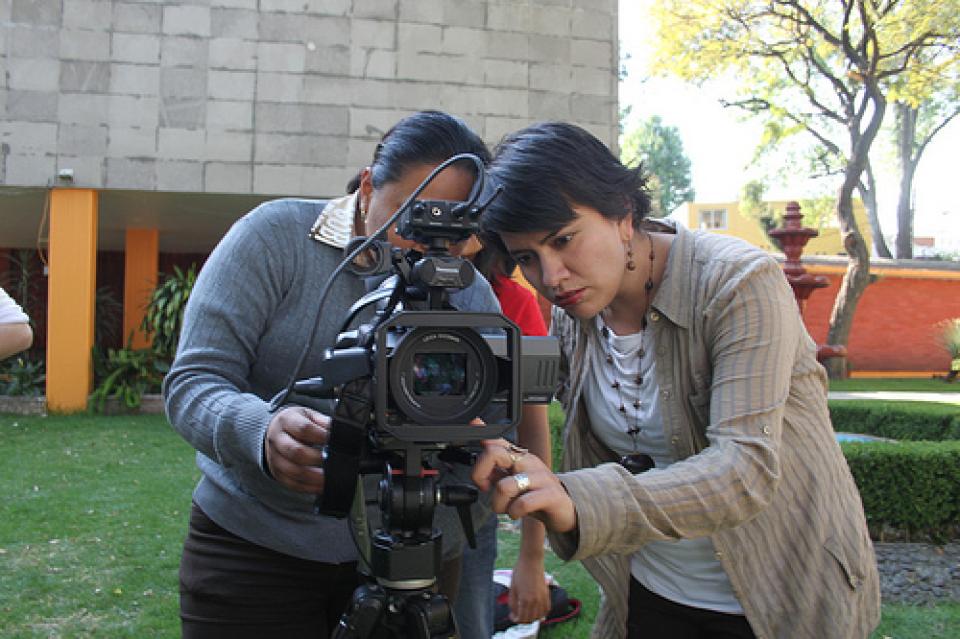
Latin American women are attaining good levels of education and training for the labour market, including knowledge of ICTs, but APC WNSP regional coordinator, Dafne Sabanes Plou acknowledges that digital inclusion as a factor in economic progress is just beginning to appear on the regional horizon and that gender equity is still sidelined from ICT policy discussions. She speaks to GenderIT.org Spanish editor Flavia Fascendini about the progress women are making in science and technology in Latin America.
Flavia Fascendini (FF): From the Latin American standpoint, what are the strong and weak points that you think exist regarding women’s access to education in science and technology? We know that the statistics on their participation in Latin America never come close to what is expected. Has this changed at all since the implementation of certain regional initiatives such as the eLAC platform1?
Dafne Sabanes Plou (DSP): With regard to education, women are doing well in Latin America and the Caribbean. In general, enrolment of girls and adolescents in primary and secondary schools is high in all the countries and, in most, women surpass men in university enrolment. Perhaps the main stumbling block is in the area of science and technology. In the area of systems and engineering in particular, the number of women does not exceed 23% of enrolment. Only Venezuela surpasses this percentage, and there we find that almost 40% of engineering professionals are women who work mostly in universities and in industry. Nevertheless, it is interesting to see that in research, in both natural and social sciences, the number of women is significant in several countries, and in the future, we will see an important increase in women scholarship-holders and researchers.
One of the positive contributions of the information society plans starting to be implemented in Latin American countries is that they focus on training and the use of ICTs in the classroom from an early age. The fact that countries have committed themselves to having a certain percentage of schools connected to the internet within a certain time and to include apprenticeships in the curricula means that thousands of boys and girls will have the opportunity to access information and knowledge through ICTs and the internet. I make the distinction because we should not forget that connectivity is not available everywhere yet and that many schools set up their computer labs using CD roms with educational content that has proven to be excellent for interactive instruction, with the participation of students who develop their skills in this way, stimulating their creativity and curiosity as well as a taste for research.
Since the opportunities are available to boys and girls on an equal basis, we will soon see if this universalisation of knowledge and access encourages girls to see their future in the field of science and technology. In Argentina, for example, 30% of the students in secondary technical schools are girls, something unimaginable a decade ago. But we shouldn’t settle for that. It would be good to see them pursue related university degrees and hold technical jobs in companies and the government. For that to happen perhaps we need to think of incentives and policies that accompany the choice. The environment in the realm of engineering and technology continues to be very male; there is subtle discrimination that should be eradicated and opportunities should be equal for men and women.
(FF): Do you think there is regional evidence that policies to promote access and participation of women have resulted in an increase of access for women to full employment and decent jobs?
(DSP): Greater participation of women in the labour market has several explanations, in addition to the economic one. We can say that access to the formal economy and better-paying jobs has to do with the fact that women are attaining good levels of education for the job market, including knowledge of ICT. I think there are currently very few urban jobs that do not demand some computer knowledge and use of technology. Examples include simple jobs like stocking merchandise in a supermarket, which must be recorded by computer, or pumping gas in a service station, which requires charging with credit cards and registering the purchase in a computer, or serving and home delivery of food, where orders are also received by internet, registered in computers, charged using credit or debit cards. In other words, if this knowledge does not exist, there is no access to jobs. Rural work is also rapidly being computerised, and there are new jobs that are not available without ICT knowledge. It is important to meet this challenge to train women and also men in this new knowledge, because otherwise decent work will be unobtainable.
(FF): Do you think Latin America is heading towards implementing ICT policies that respond to gender needs?
(DSP): We’re a long way from that. The people in charge of designing and implementing ICT policies in the region are just starting to think seriously about digital inclusion as a factor in economic progress. The view has been very technical up until now, and the influence of private enterprise in putting together the policies and discourse has been very significant. What takes precedence is business, the commercial aspect, the possibility of selling ever-more sophisticated and therefore more expensive equipment, and only for minorities that tend to work in transnational corporations.
We need to work more on a vision of ICT for development, to think about the average person, in small businesses, entrepreneurs, in people that work in the informal economy and who also need to access prices, know the movements of the market to offer their products, be in contact with appropriate marketing channels, etc. The issues of gender equity hardly enters into the discussion, and these issues are seen as demands that are out of place. Therefore, we must keep insisting and placing the topic on the discussion tables, so that it is really taken into account in planning and implementing true inclusion policies, for all men and women.
(FF): What’s your perception of representation of women in the dialogue spaces on ICT policies on the regional level?
(DSP): Gender balance does not exist. Representation consists mainly of male technicians, which involves a bias because a social and all-encompassing vision of social needs is lacking. This also means that there is not much room for clearly visualising the new roles of women in society in general and in the labour field in particular, nor that much thought is given to how it is necessary to work to break the “glass ceiling,” which is still invisible for most policymakers.
The APC WNSP in Latin America (APC WNSP LAC) has managed to become involved in the design of action plans at the regional level, which is no small feat, but we lack the capacity to do follow-up at the national or local level. To do this, it is necessary to invest time and money so that the advocates can devote themselves to the issue in greater depth ─ attending meetings, for example ─ which is not always possible. Nevertheless, in coordination with the APC Information and Communication Policy Programme we have been able to participate in advocacy settings at the regional level that were interesting because of the results obtained.
The participation of APC WNSP LAC in the entire process of the World Summit on the Information Society, being part of the CRIS campaign for the right to communication in the information society2, as well as in the design of the various eLAC plans (2007, 2010 and 2015), has given us visibility and the possibility of having a place at the discussion tables. Because of this, it was possible to include gender issues and the creation of a group on gender and ICT in both the eLAC2010 and eLAC2015 plans. We were very active in those discussions and in the lobby that had to be organised so that this group could be established and have its work recognised.
Another important achievement was that APC WNSP LAC was selected to write a report for UN Economic Commission for Latin America and the Caribbean (ECLAC) on women in labour and the economy of ICTs, which is still in the production phase. As a result, we were able to be present at the XI Conference on Women in Latin America and the Caribbean in July 2010, and to participate in the discussion of the action plan for advancing the rights of women to be implemented in the region. This action plan includes a whole section on access and strategic use of ICTs, with special concern for indigenous women and grassroots sectors.
(FF): The APC project “MDG3: Take Back the Tech! to end violence against women” which has already run almost its entire course and involves four countries in the region (Argentina, Brazil, Colombia, and Mexico) had a strong training component on the strategic use of ICTs in order to involve women in ICT policy spaces affecting their rights and gender equality. What is the outcome so far? What lessons stand out in Latin America that could be replicated at the international level? What do you think are the principle recommendations born of this project, as well as from the FTE, to be brought to spaces of debate on ICT policies in Latin America?
(DSP): We are just staring to receive the final reports from the groups of women we supported particularly in training and strategic use of ICT to prevent and work to eliminate all types of violence against women, including that which is perpetrated using ICTs. It will take us a while to do an in-depth evaluation of the results, but what was important was that the project helped strengthen the women through training and through mastering technology, not only to coordinate their actions, but also to reach the authorities, make themselves publicly visible on the internet and to thus achieve greater impact in their campaigns and actions.Also, knowing how to use computers to communicate, produce documents, edit presentations with slides, audio and small videos strengthened the women’s self-esteem. The groups can now develop their own communication strategies without depending on others, which increases their power of decision, their creativity, and ownership over their institutional projects.
It is important to know that you can do a lot with very little money, and that cell phones or regular cameras which we all use are good tools for filming and taping. It is essential to know that we can use technology so that the defense of the rights of women is not silenced, but rather can be heard and seen through all media. The experience of personal and group strengthening was very important throughout this project, especially that women begin to look at their work politically. Now they recognise that it is important to influence public officials, government plans, and local policies, to affirm and protect the right to live a life without violence.
Photo by Rotmi Enciso. Link: http://www.flickr.com/photos/produccionesymilagros/5393818937/
2005-2007: eLAC2007 with 30 goals and 70 activities for the years 2005-2007,
2008-2010: eLAC2010 with 83 goals to be achieved during the 2008-2010 period, and
2011-2015: eLAC2015 that includes 26 goals in eight areas: access, electronic government, environment, social security, productive development and innovation, enabling environment, education and institutional framework for state policy.
Source: Wikipedia.org
- 9779 views







Add new comment